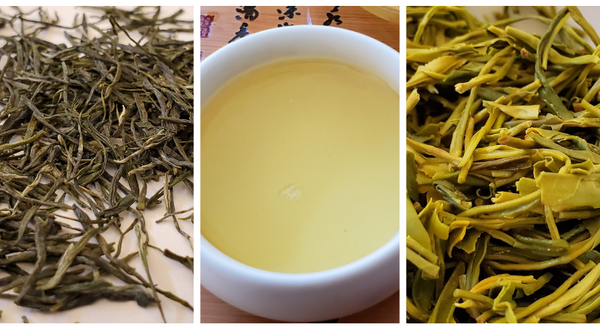-
Big Red Robe or “Da Hong Pao” is the signature tea of the Wuyi Mountains in Fujian Province, China. This tea is also known as “Rock Tea” or “Rock Oolong”, which can become confusing. It’s defining features are long, dark, twisted leaves that have been partially oxidized (like black tea) and baked (sometimes referred to as “roasted”). The flavors range widely from toasty and spicy to citrus and sweet.
Big Red Robe is said to have originated as two plants in the Tian Xin temple in Wuyi. The monks there spent a great amount of time and resources on these plants and the outcome was the now famous Big Red Robe. Though the plants do not exist in the temple anymore, it is believed to be the same plant that is growing out the side of a rock face nearby that is considered the official mother bush “Da Hong Pao” plant (Qi Dan cultivar). As to be expected, there is not 100% agreement on this as fact.

The official Mother Bush "Da Hong Pao" plant is a popular tourist attraction.
Though Big Red Robe is the source of many old and fantastic stories, a comprehensive written record of its production doesn’t appear until 1943. In 1949 the Chinese government took ownership of the original plants and placed strict protections over them, but in China’s reform era of the 1980’s the practice of using other cultivars to make Big Red Robe became routine. Now “Big Red Robe”, “Wuyi Rock Tea”, and “Rock Oolong” are all synonymous.

“Rock Oolong” and “Big Red Robe” are two different names for the same product.
The variety of cultivars used to make rock oolong will vary depending on the desired price and quality as determined by the tea maker. The most popular (and expensive) rock oolongs are made in the Wuyi mountains, but it is possible to produce similar styles elsewhere (often at lower prices and lower quality).

Wuyi Mountains, Fujian
The name on the package can lead to unnecessary confusion. “Rock Oolong” and “Big Red Robe” are two different names for the same product. This product is often a blend of cultivars that could be different from each tea seller and still retain the name “Big Red Robe”. There is also Big Red Robe made from Qi Dan or Bei Dou cultivars, each one considered the true Big Red Robe plant. However, if the rock oolong is made from 100% Rou Gui (“cinnamon”) cultivar or 100% Shui Xian (“water immortal”) cultivar, then it will usually be marketed as “Rou Gui” or “Shui Xian” and not “Big Red Robe”. These tend to be the only cultivars that get this treatment, but ultimately this is a marketing decision for the tea seller.
Rou Gui is popular right now and many tea farmers are removing Shui Xian plants and replacing them with Rou Gui. The difference between these two was summed up well by my friend when he said “Rou Gui will light you up while Shui Xian will lay you back”. Rou Gui tends to have a sharper, spicier, more intense mouthfeel where Shui Xian is softer, sweeter, and more subtle.
View Post About Top 3 Rock Teas: A Brief Definition of Big Red Robe
-
Most tea producing countries largely specialize in producing one kind of tea (and many of these are excellent). China is different. It has the knowledge, the history, the location, and the ability to make a seemingly endless and evolving variety of teas. With so many options, I’m interested in “why” tea producers choose their teas and “how” they choose to make them. I asked Mr. Tang why he makes “Golden Buddha”. He said because people like it. He is wise.
“Golden Buddha” is a black tea from the Anxi region of Fujian province. The tea cultivar (named “Mingke 1”) originated in Anxi and is commonly grown there. Mr. Tang gave it the name Golden Buddha because the cultivar is a hybrid of Tie Guan Yin (Translation: Iron Goddess of Mercy) and Huang Jin Gui (Translation: Yellow Gold) and Buddhism is popular in the region. I was scheduled to be there this spring to witness the making of Golden Buddha and gain some insight into tea production, but Covid-19 cancelled those plans. Mr. Tang is old school and doesn’t take pictures, so there are no photos to share. But my friend described tea making this way, “Check what material you got and watch the weather before making the decision.”

Tea fields in Fujian
Two ideas in particular stood out to me when we discussed this tea on my last visit (though these lessons could apply to other teas). The first was finding the right source material. Not all tea makers grow their own tea, a practice that is becoming more common and opening up opportunities to new talent. When searching for the right location for leaf material, he checks the soil surrounding the plants for life, such as earthworms. As my friend Daniel said, “No grass is no good.” However, if the new leaf is dark green in color, that means food is being made available to the plants and that could yield low quality tea. Mature and healthy tea plants are self-sufficient with strong roots that find their necessities deep underground. According to the “Tea Classic” book, “The best tea grows on rotten stones.” Tea plants can live hundreds of years in the right conditions…and location matters.

A close-up of the "Mingke 1" tea cultivar
The second aspect was what guided his decision-making during production. After plucking and withering, Mr. Tang applies a shaking technique typically reserved for oolong. Applying this to the production of black tea is relatively new and not common. The purpose is to improve the aroma and texture when nuance is the goal (rather than strength). The specifics for how to apply this technique are different for black tea, which should not be shaken as hard as oolong. If there were a “by-the book” method for shaking black tea it would be “two shakings for four minutes each”, but he says it’s impossible to make high-quality tea this way. For the best results, the tea requires constant guidance through a series of moments that are largely out of your control. It’s this process that attracted my attention.
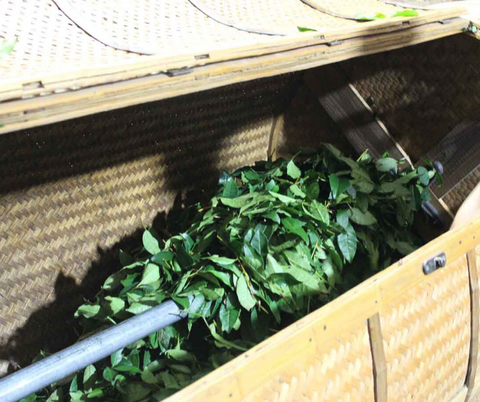
Shaking the leaves
For Golden Buddha, he says the first shaking (four minutes) is used to “wake up” the leaves. This will release the aroma (sweet, floral, potent, and memorable) and cause the leaves to stiffen as water transfers from the stem. After an hour’s rest (the leaves will now be soft and yellowish from moisture loss), he will shake it again and longer this time (maybe 15-18 minutes), depending on the leaf and the weather conditions. This second shaking will cause the leaf edges to turn red, release more aroma, and cause the material to stiffen up again as more moisture travels from the stem to the leaf. He would typically let is rest overnight to become limp and ready for rolling the next day. Rolling the tea may be longer for spring leaf, lighter for old leaf. Harder on a rainy day, shorter on a summer day. But no straight answers on any day.
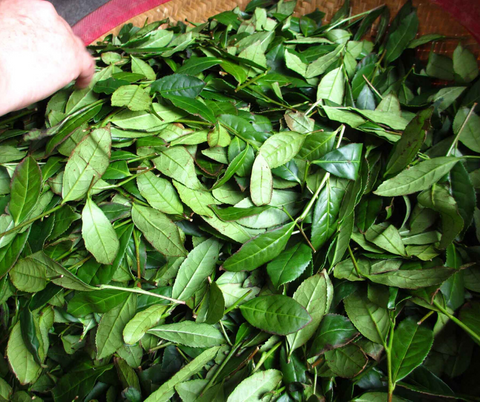
The edges of the leaves turn red after shaking
Tea is an end unto itself, like music. I do not consider tea “functional”, though there’s nothing wrong with using it that way. It’s easy to appreciate when we suspend our expectations of it and instead ask the makers how they make it. If you want to make Golden Buddha at home the recipe is picking -> withering -> shaking -> rolling -> oxidization -> drying. Let me know how it goes and remember to “check what material you got and watch the weather before making the decision.”
This blog was written with help from our friend Daniel Hong.
-Michael Lannier
-
I’ve written about Mr. Lin Rui Fu before and don’t hide my admiration for him. As a guy from a Midwestern, blue-collar family, I relate to his hard-work, high-quality, no-nonsense approach. Most Chinese tea makers and traders have an ornate room with a tea table and fine tea ware to entertain their guests (and I have no problem with this aesthetic). Mr. Lin has a small, spartan tea room resembling the office of the local auto mechanic.

Mr. Lin in his tea fields
His tea is some of the best quality oolong tea I have come across. Growing at a high altitude of 2,400 feet, the tea plants are perfectly manicured lines wrapped around the mountains. The tea, the fields, and the factory are all immaculate and the homemade food upstairs is my favorite. Below is a comparison of our current teas from him which highlight basic Anxi tea styles.
Golden Dawn Oolong Tea
(Gongfu steeping - 6 grams | 6 oz water | 195°F | Rinse 5 sec. | Steep 30 sec | Repeat)

More commonly known as Huang Jin Gui, the locals call this tea “Huang Dan” (Yellow/Morning-Dawn). To be properly understood, it should be appreciated for the way it yields. This tea is pristinely clean and light and seems to digest like light rain on ready soil. The most prominent aspects of the flavor are its dark mineral notes, acting more like rests in a good beat - felt rather than noticed. Huang Jin Gui is famous for its aroma which is clean, lightly floral, and pleasantly lacks any thickness of perfume or broth. This cup of tea goes down easy, doesn’t linger long, and seems to always take the path of least resistance. It’s an everyman’s everyday tea and doesn’t require you to pay attention to it to be appreciated.It’s not the tea I bring out to impress my friends, but I drink a lot of it, especially in the morning.
Iron Goddess of Mercy Oolong Tea
(Gongfu steeping - 6 grams | 6 oz water | 195°F | Rinse 5 sec. | Steep 30 sec | Repeat)

Ti Kwan Yin, a classic Chinese oolong tea, translates as “Iron Goddess of Mercy” - and such great names are always worth noting. This is a traditional version with a moderate amount of baking in the final step of processing. Ti Kwan Yin and Huang Jin Gui are both named after the tea plant cultivar used to make the tea and are often processed in similar ways. However, each possesses unique attributes, and the thick tea leaves of Ti Kwan Yin tend to give it a fuller and more pronounced flavor and mouthfeel, where Huang Jin Gui tends to highlight the aroma. The dark color of the liquor can be misleading as it is surprisingly light in body and floral in character. The baking brings out depth more than toastiness – a warm familiarity in the gut rather than frills and fancy on the palette. This cup of tea is not too fussy when you steep it, either, and stays knowable and dependable on each visit. It’s not a tea to get in the way of a moment, but a tea you wanted to be there.
Huang Jin Gui Full Roast Oolong Tea
(Gongfu steeping - 6 grams | 6 oz water | 195°F | Rinse 5 sec. | Steep 30 sec | Repeat)

Sometimes the best way to judge the quality is to hold it in your hands. The finer details of craftsmanship tend to reveal themselves at these moments. Though this tea is the same tea plant cultivar as our Golden Dawn Oolong, the similarities end there. As stated in the name, this tea gets the traditional baking that brings out depth by sending the flavor into the body rather than up into the nasal cavities like “green” oolong tend to do. It has a full body and oily mouthfeel that allows those dark, sugary flavors to linger. The aroma is stacked, but stays surprisingly floral instead of charcoal-like, which is the sign of skilled baking by Mr. Lin. There’s a certain comfort in this cup of tea - like the old country music lyric “sometimes this old farm feels like a long-lost friend.” If you don’t have an old farm, this tea gets you similar sentiments - a loyal companion to everyday life.
-Michael
-
Here’s a quick comparison of the three most recent sheng puer arrivals. Each was steeped in 150ml gaiwan with 8 grams of tea, 15 second rinse, and then 20 second steeps (with close-to-boiling water each time).
This is the softest of the three. It was made by Mr. Yang Xiu Hai, the same gentleman who made our 2018 Yiwu Sheng Puer, though this one comes from the Menghai region. It’s light and fruity – reminds me of those mornings where breakfast was a quick bowl of instant peaches and cream oatmeal (with hoppy beer added to your oatmeal – not that I’ve ever done that…). There are small mineral and bitter elements that service the cup like pinches of salt to the cookie dough recipe. The mouthfeel is soft and smooth and memories of grapefruit in the exhale. This tea has an important quality that our typical assessments have no words for - it just feels good to drink. Some teas feel good because they taste good. Some teas feel good because they are ritualistic or nostalgic. All these are good reasons to drink those teas. But I swear there is an objective measure for teas that just plain feel good. This tea is gentle and present. The most important things rise to the top without saying much at all. Like a sad song without lyrics, you just know.
This is the most complex of the teas mentioned here. It was made by Mr. Zhao Tian, who lives on the famous tea producing mountain of Nan Nuo Shan (see blog post for more about him). The steeped aroma of this one is a bit damp and fishy, maybe gamey. If you haven’t had much puer tea before, you may not find it pleasant. But as it cools, the aroma sweetens up like apricots. Puer teas can have a “wildness” to their character that’s just difficult to describe other than…wild. When I attempt to describe it, I often say off-putting things like those above, but they are terms of endearment. Those untamed savory/charcoal-like flavors get balanced with familiars like hops and grains. The mouthfeel has a granite-like texture (without all the weight that implies) and there’s a certain electrical intensity to the cup (not quite bitter, not quite astringent) that seems to be uniquely present in some puer teas. It starts out light, but intensifies through the second and third steeps. Even the 4th and 5th steeps are still very present while becoming more subtle. It is not sweet, it is not soft, it is not simple, but still very easy to drink. Like a good riddle, it lacks many affirmatives, but you enjoy it none the less.
This tea is the strongest of the bunch and the most affordable (those two attributes have no inherent connection). It was made by Mr. Liu Zhao Quan, a tea-school classmate of our mutual friend Mr. Tang. This tea has a notable sharpness, which is not bad, but it will make its presence known. It can easily be controlled by reducing the amount of leaf used or limiting steep times, but I wouldn’t shy away from the challenge if you’re willing. The floral/bitter/charcoal flavors flex their muscles early with a full and oily mouthfeel. It’s a good performance, but it can overpower if you’re not careful. The tea is warming and travels to the gut quickly, which lasts much longer than the aftertaste in the mouth. These are admirable qualities for an inexpensive puer and I highly recommend it as an everyday tea. The landscape on this one flattens out sooner than the others mentioned here, but you can still easily get 4-5 steeps. Those last rounds have a gentler, melon-like sweetness that makes for a pleasant finish, but it signals that the house lights are about to come on and the show is over.
-

Puer cakes being wrapped in bamboo "tongs" in Kunming, Yunnan
To be fair, puer tea can be difficult. The flavors and aromas don’t lend themselves to the obvious charms of sugars and salts. It’s not mysterious in a mystical sense, but quality information is elusive and this tea doesn’t fit neatly into a commoditized category like black tea or green tea. Its simplicity adds to its complexity, hence the trouble with giving it a firm definition.

Drinking puer with Mr. Zhao at his home in Nan Nuo Mountain in Yunnan
But I’m going to attempt to give it a working definition anyways. I will not address what it tastes like - it’s enough just to respond to “what is puer tea”? The below explanation assumes you have some understanding of how tea is made. I lack the skill to summarize without these assumptions.
 Freshly picked "Yunnan Big Leaf" tea for making puer
Freshly picked "Yunnan Big Leaf" tea for making puerAll puer is made using the Yunnan-grown assamica leaf. If it is made with the small leaf Camellia sinensis, it is generally not considered puer.

A small village in the town of Jing Mai, Yunnan
All puer tea comes from Yunnan, particularly the southwest areas of Lincang, Xishuangbanna, and Puer (hence the name). Even if the tea making process is the same, but if the tea material is not from Yunnan (particularly those three areas), it is not considered puer tea.

Sheng puer mao cha (loose leaf tea) from Mr. Zhao's spring 2019 lot
To be brief, puer tea comes in two very different styles: sheng puer (raw) and shu puer (ripe). Sheng puer is a simple non-oxidized tea whose finished product will change naturally over time. Shu puer starts out as sheng puer, but goes through one more deliberate and accelerated “post fermentation” process to speed up this change into a matter of weeks as opposed to years. However, these two styles of tea couldn't be more different.

Shu puer in the first stage of the post fermentation process
Sheng puer is a simple tea to make and goes through some similar processes as other tea, but there are two essential distinctions. The “kill-green” step is not as thorough as green tea, leaving the elements for oxidation somewhat intact. Also, puer tea is always finished by air drying, not machine drying, so the moisture loss is always imperfect. These two facts are critical. It preserves the elements of change within the leaf that become apparent with age.

The liquor of a 1988 sheng puer from Ms. Zhao
Both styles of puer tea can be drunk immediately after they’re made or can be aged indefinitely. There is no minimum age to define puer tea. However, the qualities of sheng puer will change considerably over the course of years. The change in shu puer is less dramatic.

Puer cakes in a special room for long-term storage
When aging puer tea, the environmental conditions during storage can vary widely and will have a signature impact on how it changes. It’s not uncommon for puer tea to be sent to Guangdong or Hong Kong to be stored in its warm and humid climate, which will cause the changes to be faster and more intense. Yunnan is cooler and dryer and so the pace of change is slower and more subtle. There is no universally agreed upon method of which storage is better. They are just different.
 Small, medium, and large tea trees from Mr. Zhao's fields in Nan Nuo Shan
Small, medium, and large tea trees from Mr. Zhao's fields in Nan Nuo ShanBecause of puer tea’s simplicity, the small details – the mountain, the tea tree, the season, the weather conditions – all play a pivotal role. It’s not hard for the puer tea enthusiast to get lost in the minutia of these details – and like baseball statistics when I was a kid; they are fun to get lost in. But it’s best not to take them too seriously. Statistics don’t always guarantee performance.

Traditional pressing stones for tea cakes
If you’re still reading, I hope this brings puer tea a little more into focus. This is not an official definition of puer. I am not qualified to give one. Any of the above parameters can and are being disputed by someone. It doesn’t matter. Always let the tea speak for itself.
-Michael
-
Here’s a compare and contrast of three Chinese green teas we received in 2019:
- Gu Zhang Mao Jian
- Dragonwell Superior
- Wuling Mountain Yunwu
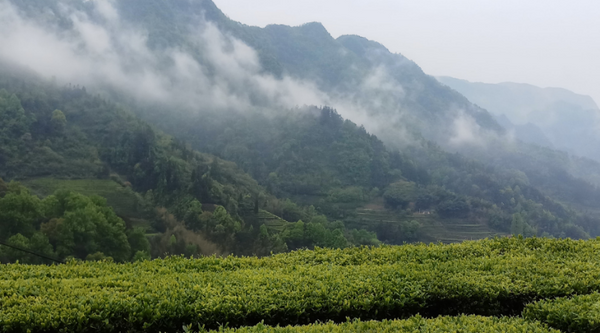
Wuling Mountains in Hunan Province, China
Each steep was 8 grams tea, 5 ounces of 180 degree water, steeped 30 seconds in a gaiwan. Normally I would not make the tea this strong, but for the purpose of this multi-steep evaluation I wanted to pull out more elements quicker. There’s no strict rule about how many grams to put in the gaiwan or how long/hot to steep it (I’m sure some of you disagree), but I would dial it back a bit based on my own preferences.
Gu Zhang Mao Jian - Buy this tea
Attractive looking, tightly twisted, dark green leaf. The steeped aroma is that garden-like vegetal floral that I’m a big fan of (because I garden). The cup is a dark, deep, vegetal flavor, sharp, and a savory broth that’s not too soupy. It has an oily mouthfeel and a slight, pleasant bitterness. The body and mouthfeel are sustained through second and third steeps, but the bitterness starts to take a back seat to more floral flavors and an undefined sweetness. It warms up the body more than most Chinese greens. A very full experience. Touches all bases.
Dragonwell Superior
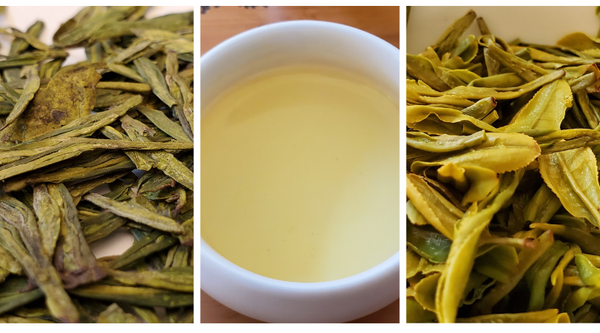
Those iconic flat, little, yellow-green leaves are in high demand in the tea world. Its unique qualities are well on display here. The cup is grassy with a strong nutty flavor and lots of little nooks and crannies for nuances like a little floral here, a little bitter there, maybe a brussel sprout over here. It continues to distinguish itself as it refuses to diminish through the second and third steeps. The edges do soften a little with the nutty quality giving way to more floral flavors. Its presence lingers strong in the mouth for as long as you wish.
Wuling Mountain Yunwu

This is classic Chinese green tea! Its dull green leaves are twisted and curled. The cup is a combination of leafy greens, chicken broth, and flowers. The soft mouthfeel makes the liquor go down easy and is largely forgiving of any bitterness. The body and flavor of this tea fade quicker than the Gu Zhang Mao Jian and Dragonwell, but it’s an excellent value and the aroma is first class!
-Michael Lannier
View Post About Comparative Cupping: 2019 Chinese Green Teas























